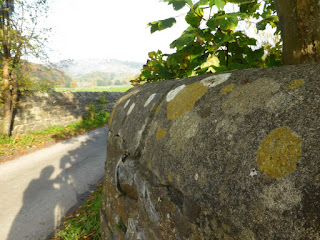Learn your lichens 2.
Distribution map of Caloplaca flavovirescens in UK
Caloplaca flavovirescens forms big pale yellow egg-yolk coloured patches (up to 15 or 20cm) and the margin of the patch is whitish. It should be called Fried Egg Lichen.
Around here it seems to grow on cement type substrata.
I have found it in four places:
1. E and J's house doorstep, Stackhouse Lane
2. The Locks, Langcliffe
3. One patch on a stone in the north wall at Horton Churchyard
4. Paving stone beside War Memorial outside Ingleton Churchyard
1. It grows on the front doorstep of a house on Stackhouse Lane overlooking the school
 |
| A drop of strong alkali - in this case sodium hydroxide solution - turns the minute fruiting bodies from orange to crimson |
 |
| Here, another species of Caloplaca (Caloplaca holocarpa - grey with orange fruiting bodies) isgrowing next to it, and prevents the C flavovirescens from making a circular patch |
 |
| Frank Dobson's Lichens book is placed near the Caloplaca flavo-virescens, with a view across the road to the school trees |
 |
| Reverse view. |
 |
| Stackhouse Lane in autumn |
I was first shown Caloplaca flavovirescens at Ingleton at the war memorial outside the church
 |
| Caloplaca flavovirescens |
 |
| Caloplaca flavovirescens - This turns red with alkali |
 |
| Caloplaca flavovirescens |
-----------------------------------------------------------------------
 |
| This is front right in the picture above,.. though it is on the wall to the left of me above that |
 |
| Next to the stile |
 |
| The same ones looking to the bridge |
 |
| The same ones larger Finally an autumn view of the river |







































